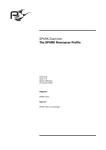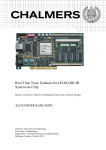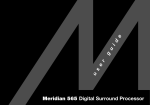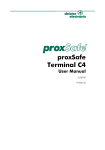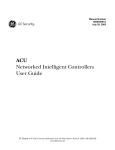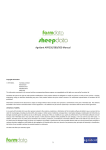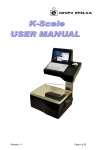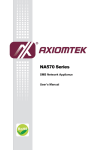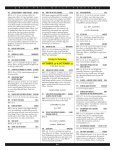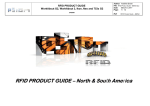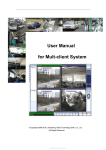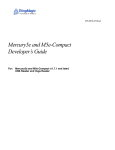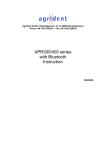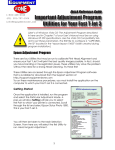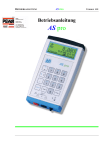Download ASR700 man_e
Transcript
Agrident GmbH, Steinklippenstr. 10, D-30890 Barsinghausen Phone +49 5105 520614 - Fax +49 5105 520616 ASR700 Reader Operation Manual V08/08/06 ASR700 Reader Operation © Copyright 2006 by Agrident GmbH All rights reserved. No part of this publication may be reproduced, stored in a retrieval system, or transmitted, in any form or by any means, electronic, mechanical, photocopying, recording or otherwise, without prior written permission of Agrident GmbH. Agrident GmbH reserves the right to make changes to any and all parts of this documentation without obligation to notify any person or entity of such changes. August 2006 (BUS/JR) Agrident GmbH Steinklippenstr. 10 30890 Barsinghausen Germany Phone +49 (0) 51 05 520614 Fax +49 (0) 51 05 520616 E-Mail: [email protected] www.agrident.com 08.08.2006 Page 2 of 55 ASR700 Reader Operation Contents 1. Introduction.......................................................................................................... 6 1.1 2. ASR700 Hardware .............................................................................................. 7 2.1 Description ............................................................................................ 7 2.1.2 Contact less identification with RFID..................................................... 7 2.1.3 Transponder types supported ............................................................... 7 Installing and connecting the ASR700 and antenna..................................... 8 2.2.1 Installing the housing ............................................................................ 8 2.2.2 Fitting the antenna ................................................................................ 9 2.2.3 Electrical connection ........................................................................... 10 2.2.4 Auto tuning .......................................................................................... 16 2.3 4. Application.................................................................................................... 7 2.1.1 2.2 3. Definition of terms ........................................................................................ 6 Operation ................................................................................................... 24 2.3.1 Basic settings ...................................................................................... 24 2.3.2 First-time use of the ASR700 – an example........................................ 24 2.3.3 Read function ...................................................................................... 24 2.3.4 Displaying the read function ................................................................ 24 2.3.5 Output of the transponder data ........................................................... 25 2.3.6 Connecting the reader to a control computer ...................................... 26 Operating modes............................................................................................... 27 3.1 Operating in slave request mode (Cfg_mode register 0x02) ...................... 27 3.2 Operating in slave continuous mode (Cfg_mode register 0x01)................. 28 3.3 Operating in master mode (Cfg_mode register 0x00) ................................ 29 Configuration of the ASR700 reader ................................................................. 30 4.1 Factory configuration.................................................................................. 30 4.2 Configuration possibilities........................................................................... 30 4.3 Description of the individual registers......................................................... 31 4.3.1 Cfg_Delaytime..................................................................................... 31 4.3.2 Cfg_Format ......................................................................................... 31 4.3.3 Cfg_Mode............................................................................................ 32 4.3.4 Cfg_Node ............................................................................................ 32 4.3.5 Cfg_RF................................................................................................ 32 4.3.6 Cfg_Timeout........................................................................................ 32 4.3.7 Cfg_Optimisations............................................................................... 33 08.08.2006 Page 3 of 55 ASR700 Reader Operation 5. Protocol description ........................................................................................... 34 5.1 Interface parameter .................................................................................... 34 5.2 Frame......................................................................................................... 34 5.3 Control codes ............................................................................................. 34 5.4 Escape sequence....................................................................................... 34 5.5 Addresses .................................................................................................. 34 5.5.1 Destination address DST .................................................................... 34 5.5.2 Source address SRC .......................................................................... 34 5.5.3 Address ranges ................................................................................... 34 5.5.4 Device type addresses........................................................................ 35 5.6 Message commands and acknowledgements............................................ 36 5.7 Description of the individual messages ...................................................... 37 5.7.1 Connect_RQ ....................................................................................... 37 5.7.2 Get_Amplitude .................................................................................... 37 5.7.3 Get_Config .......................................................................................... 37 5.7.4 Get_HDX_Sample............................................................................... 37 5.7.5 Get_Last_ID ........................................................................................ 38 5.7.6 Get_Phase .......................................................................................... 38 5.7.7 Get_PhaseAmplitude .......................................................................... 38 5.7.8 Get_RSSI ............................................................................................ 38 5.7.9 Get_Single_ID..................................................................................... 39 5.7.10 Get_SNR............................................................................................. 39 5.7.11 Get_TuningResult ............................................................................... 39 5.7.12 Get_Tuning ......................................................................................... 40 5.7.13 Get_Version ........................................................................................ 40 5.7.14 Reset_All............................................................................................. 40 5.7.15 Retransmit_Request ........................................................................... 41 5.7.16 Save_Config........................................................................................ 41 5.7.17 Set_Config .......................................................................................... 41 5.7.18 Set_TuningData .................................................................................. 41 5.7.19 Start_AutoTuning ................................................................................ 42 5.8 Description of the acknowledgements........................................................ 42 5.8.1 ACK..................................................................................................... 42 5.8.2 NAK..................................................................................................... 42 5.9 ID-Format ................................................................................................... 42 5.9.1 Format of ID ........................................................................................ 42 5.9.2 ID-without time stamp ......................................................................... 42 08.08.2006 Page 4 of 55 ASR700 Reader Operation 5.9.3 ID- with time stamp ............................................................................. 43 5.9.4 Example ID- without time stamp Format ASCII ................................... 43 5.9.5 Example ID- without time stamp Format ASCII and SCP format......... 43 5.9.6 Example ID- without time stamp Format ASCII short format............... 43 5.9.7 Example ID- without time stamp Format ASCII short format 16.......... 44 5.10 CRC Calculation......................................................................................... 45 5.10.1 6. CRC-Algorithm .................................................................................... 45 Clock synchronisation of ASR 700 readers ....................................................... 46 6.1 Installation .................................................................................................. 46 6.2 Setting at the ASR700................................................................................ 46 7. Technical data ................................................................................................... 48 8. Influence of noise, Interference and metal objects on the reading range .......... 49 8.1 Computer monitors..................................................................................... 49 8.2 Other electronic equipment ........................................................................ 49 8.3 Data cables ................................................................................................ 49 8.4 Mains cables .............................................................................................. 49 8.5 Fluorescent and Low Voltage Lighting ....................................................... 50 8.6 Other readers ............................................................................................. 50 8.7 Effects of metal near readers ..................................................................... 50 9. Safety and care ................................................................................................. 51 10. Warranty ........................................................................................................ 51 11. Appendix........................................................................................................ 52 11.1 RF synchronisation..................................................................................... 52 11.2 Description of commands and acknowledgements .................................... 52 11.3 Description of the registers......................................................................... 53 11.4 Factory configuration.................................................................................. 54 12. Trouble shooting ............................................................................................ 55 08.08.2006 Page 5 of 55 ASR700 Reader Operation 1. Introduction Before attempting to use the product for the first time read through the user manual carefully. The functional description of the ASR700 reader will help you make best use of the full capabilities of the system. The protocol description in chapter 5 provides you with all the information you need to integrate the reader into your own application software. 1.1 Definition of terms Explanation of abbreviations used in this user manual RF: RFID: Radio Frequency (in this case the long-wave band) Radio Frequency Identification. Method to transmit data without contact using transponders. Reader: A device which is able to communicate with transponders using an internal or external antenna. The reader generates a high frequency field in order to get the data of a transponder. The received data is transmitted by an interface to an external controller (e.g. PC etc.). Transponder: Data carrier for RFID applications, available in various models and types. Raw data: Complete data contents of a transponder, which means ID and additional information (for example header or trailer). ID: Identification number of a transponder. ISO 11784/85: International standard regarding the use of RFID technology in the identification of animals; it defines the transponder types to be supported and the ID notation. FDX: Transponder type, which transmits its data while the HF field, is on (full duplex). FDX-B: FDX transponder with 128 bits of raw data, ID notation in compliance with ISO 11784/85. HDX: Transponder type, which transmits its data directly after HF field, goes off (half duplex). 104 bits of raw data, ID notation in compliance with ISO 11784/85. Master mode: Read mode in which the reader works as master. The reader makes field on and off permanently and transmits received transponder data automatically. Slave request: Read mode in which the field is normally off. The reader makes field on and off only after a request by the controller. If a transponder was read during activation time the ID is transmitted to the controller. Slave continuous: Read mode in which the reader makes field on and off permanently. The reader transmits received transponder data only after a request from an external controller. 08.08.2006 Page 6 of 55 ASR700 Reader Operation 2. ASR700 Hardware 2.1 Application 2.1.1 Description The ASR700 is a stationary reader, which is used for contact less identification in combination with passive transponders. The hardware of the ASR700 reader is designed for noisy environments. With the on board signal processor it is possible to read transponders where other readers could not detect them (for example in slaughterhouses). It has been developed for stationary use. Combined with one of our antennas it provides a flexible and universal RFID system. Antennas with various dimensions and read ranges are available to closely match individual requirements. The ASR700 reader is compatible with the ISO 11784/5 standard and can read HDX- or FDX-B compatible transponders. The transponders are registered within an extremely short time and over a wide detection area. Individual parameters of the read function can be configured. It can be run using a computer, but application software is then required to drive the reader and to further process the transponder data supplied. The message format of the transmitted transponder data is configurable. For description of the data protocol see chapter 5. 2.1.2 Contact less identification with RFID How RF identification works. The items to be identified are fitted with passive transponders, which contain the identification data. A reader is required for communication with the transponders. The reader generates a high frequency field using an antenna. This high frequency field activates each transponder, which is inside the reading range. The high frequency field is used for supplying the transponder with energy and for transmitting the transponder data to the reader. From the received data, the reader generates a data block (ID message). This ID message is sent out by an interface to a controller for further processing. The reading range depends on the antenna and the environment. The following things may influence the reading range (see also chapter 8): • Mounting antenna on or near metal • Noisy environment (for example electrical machines, screens etc.) • Antenna mistuned (see chapter 2.2.4 auto tuning for details) The demonstration software Asrdemo.exe includes tools for checking the tuning state of the antenna and the noise of the environment. 2.1.3 Transponder types supported The ASR700 reader is compatible with the ISO 11784/5 standard and can read HDX- or FDX-B compatible transponders. 08.08.2006 Page 7 of 55 ASR700 Reader Operation 2.2 Installing and connecting the ASR700 and antenna 2.2.1 Installing the housing A mounting hole is provided at each of the four corners of the bottom part of the housing to allow installation of the ASR700 reader. The holes are accessible after removal of the housing cover. Four suitable screws are needed to mount the unit at the place of installation. We recommend flat head screws. Figure 1: Installing the housing 08.08.2006 Page 8 of 55 ASR700 Reader Operation 2.2.2 Fitting the antenna If at all possible the antenna should not be permanently exposed to direct sunlight; installing the device in an area sheltered from ultraviolet light will extend its service life. Installing in the immediate vicinity of metallic objects may lead to detuning of the antenna. For this reason do not tune the antenna before the antenna has been installed. Avoid fitting to metallic surfaces since this may result in severe reduction of the reading distance. To fasten the antenna to the base, use flat head screws with a thread diameter not greater than 5 mm as well as suitable washers. Do not use dish-head screws for this purpose as this could lead to the plastic frame being damaged. The connecting cable to the reader should be fastened in place with cable clips or similar in such a way that the cable does not project and thus become a potential danger. Important! For advice regarding choosing a suitable antenna, contact the ASR700 dealer. Under no circumstances is it permitted, for functional reasons or in connection with equipment approvals, to lengthen the cable of the antenna. For information on tuning see chapter 2.2.4. Figure 2: Antenna 08.08.2006 Page 9 of 55 ASR700 Reader Operation 2.2.3 Electrical connection The electrical connections for the power supply, the communication interfaces with the controller (RS232 or RS485), and for connecting the antenna are made via terminal strips st2 and st7 on the printed circuit board. The corresponding cables are routed through the watertight screwed conduit cable entries. We recommended that the interface cable be routed through the screwed conduit entry PG3, the power supply cable through PG4 and the antenna cable through PG5. Connections for synchronization should be routed through PG1 and PG2. Important! Please close the unused screwed conduit entries with the enclosed blind plugs. Please use only round cables, otherwise the protection class cannot be guaranteed. To ensure the water tightness thoroughly tightens the screwed conduit entries. ST1 Additional tuning capacitors ST2 Antenna ST7 Power supply, communication interface and synchronization ST4,ST5 LED's D1 (red) ,D2 (green) and D9 (yellow) and tuning switch ST3,ST6,ST10,ST11,ST12,ST13 Reserved for internal use ST8,ST9 Reserved for future use LED1,2,3 Tuning indicators, power on (yellow) and good read (green) LED22 Indicator for polyswitch LED12,18,20,26,27,28,29,30 Reserved for service J13 Master/Slave selection if synchronisation is needed J14,15,16 Communication interface selection Switch S1,S2 Reserved for internal use Their function is described in the next sections. PG5 08.08.2006 PG4 PG3 PG2 PG1 Page 10 of 55 ASR700 Reader Operation Communication interfaces To select and activate the required communication interface the jumpers J4, J5 and J6 must be set as follows: TxD RxD GND Figure 3: Jumper settings for RS232 Terminal block ST7 3 4 5 Interface connection RS232 Meaning J4 J5 J6 TxD See Figure 3 RxD GND An RS232 interface needs three wires (TxD, RxD and GND) TxD: Where a device transmits data RxD: Where a device receives data GND: Ground 08.08.2006 Page 11 of 55 ASR700 Reader Operation To use the RS232 interface, connect TxD of the PC to RxD of the ASR700/766, RxD of the PC to TxD of the ASR700/766 and both Ground signals. ASR700/766 ST7 Pin 3 TxD Pin 4 RxD Pin 5 GND Connection PC SUB-D 9 pole Pin 2 RxD Pin 3 TxD Pin 5 GND To detect TxD and RxD disconnect the data lines (TxD and RxD). Do Voltage measurement between Ground and one of the lines. The TxD line should be approximately –12V (could be less) The RxD line should be approximately 0V. A B GND Figure 4: Jumper settings for RS485 Terminal block ST7 3 4 5 08.08.2006 Interface connection RS485 Meaning A / T+ / R+ B / T- / RGND J4 J5 J6 See Figure 4 Page 12 of 55 ASR700 Reader Operation Power supply Connecting terminals 1 (+) and 2 (-) are available on terminal block ST4. A linear regulated power supply of 13,8V is recommended (ripple must be smaller than 50mV). Maximum current is 1A. Typical current is 700mA. Terminal block ST7 1 2 Power supply Meaning Power supply +13,8V Power supply - After connecting the power supply to the ASR700, the yellow LED lights, indicating the ASR700 is ready for work. The green LED is on after a transponder was read. If the red LED is on, a tuning procedure for the antenna is necessary. During the tuning process the LED's have different meanings (see chapter 2.2.4). Important! The chassis ground (GND) of the reader must be connected to the protective conductor of the supply network. If the antenna is integrated into a metal structure this structure should also be connected to the protective conductor of the supply network. 08.08.2006 Page 13 of 55 ASR700 Reader Operation External signals and auto tuning The following schematic figures show how to connect external LEDs and the auto-tuning switch. 13,8V -ve Pin1 Figure 5: Connection diagram ASR700/766 08.08.2006 Page 14 of 55 ASR700 Reader Operation Figure 6: Connection diagram for LEDs and auto tuning switch Terminal block ST4 1 2 3 4 5 6 7 8 LEDs and auto tuning switch Meaning +5V Output Red LED (open collector with R = 470Ω) +5V Output Yellow LED (open collector with R = 470Ω) +5V Output Green LED (open collector with R = 470Ω) Input for auto tuning switch GND Terminal block ST5 1 2 3 4 5 6 7 8 LEDs and auto tuning switch Meaning +5V Output Red LED (open collector with R = 470Ω) +5V Output Yellow LED (open collector with R = 470Ω) +5V Output Green LED (open collector without R) Input for auto tuning switch GND Important! If using terminal block ST5 (RJ45 connector), there is no built in resistor on the open collector output pin 6. An external resistor (RV) has to be connected. 08.08.2006 Page 15 of 55 ASR700 Reader Operation Antennas The antenna is connected to terminal block ST2 Terminal block ST2 1 2 3 Antenna connection Meaning Antenna A1 (transparent white) Antenna A2 (transparent pink) Shield G 2.2.4 Auto tuning Every individual antenna will have an inductivity, which deviates slightly from the reference value. Another important tuning criteria are the environment of the mounting place (metal near the antenna, temperature drift etc.). The environment will influence the inductance and the Q factor of the antenna. For example metal near the antenna reduces the Q factor and the inductance of the antenna. The inductivity of the externally connected antenna together with the capacitors on the board forms a resonant circuit. It should be tuned to the nominal frequency of 134 kHz. To get the optimum reading range it's necessary to adapt the capacitor to the antenna. To find the optimal tuning for each antenna and each environment, an auto tuning function is implemented in the ASR700. Auto tuning means to automatically get the optimal tuning (which means the optimal reading range) for the combination of reader, antenna and environment. If one of the parameters changes (for example the antenna is mounted in another place), a new auto tuning procedure has to be done, in order to adapt the reader antenna combination to the new environment. Auto tuning is done by a few switch able capacitors on board the ASR700. The auto tuning works only in a certain area (fine tuning). If the maximum peak is outside this area, there are two additional capacitors which can be switch on or off by setting or removing the jumpers on ST1. For to start the auto tuning function it's necessary to connect pin 7 and pin 8 of terminal block ST4 or ST5 or send an auto tuning command from the controller to the ASR700 (see chapter 5.7.19). 08.08.2006 Page 16 of 55 ASR700 Reader Operation Activating the Tune button on the front of the reader starts auto tuning. After starting the auto tuning the yellow LED and the red LED are on. The reader now measures the voltage of the antenna for all capacitor combinations. After measuring the tuning cycle is represented optically. All LED's switch off. The optical representation starts with the yellow LED, followed by the green LED and finishes with the red LED. Flashing of one or two of the LED’s shows the final result of the auto tuning procedure: Signalisation Red LED is flashing Red and green LED's are flashing Green LED is flashing Yellow and green LED's are flashing Yellow LED is flashing Meaning Capacitance to low, set one of the jumpers on terminal block ST1 and repeat auto tuning Capacitance a bit to low, set one of the jumpers on terminal block ST1 and repeat auto tuning Auto tuning successful Capacitance a bit too high, remove one of the jumpers on terminal block ST1 and repeat auto tuning Capacitance too high, remove one of the jumpers on terminal block ST1 and repeat auto tuning Table 1: LED meaning of auto tuning result Important! Do not hold a transponder into the antenna field during the auto tuning process or during the request of tuning status. The auto tuning procedure should be repeated until only the green LED is flashing. If necessary, remove or set one of the jumpers on terminal block ST1 (see Table 1). If it is not possible, the inductance of the antenna used might be too low or too high. After auto tuning is finished, the yellow LED is on and the red LED is off. If the red LED is on, there were some changes in the environment (e.g.: temperature drift or metal is placed near the antenna etc.). In this case a new auto tuning procedure is recommended to get the optimum reading range. Note: The red LED does not mean, that the reader is not able to read transponders. The red LED only means, that the combination of reader, antenna and environment is not optimally tuned. The green LED represents the top of the tuning curve (see the following examples). The yellow LED represents the area left from the top of the tuning curve and the red LED represents the area right from the top of the tuning curve. That means if the yellow LED is on for approximately the same time as the red LED, the top of the tuning curve is in the middle, which is optimal. 08.08.2006 Page 17 of 55 ASR700 Reader Operation Example: Optimal tuning curve In this example as a result only the green LED is flashing. The time of the yellow LED is approximately the same time of the red LED. Don't care about additional peaks. Figure 7: Example for optimal tuning curve Example: Tuning curve ok In this example as a result only the green LED is flashing. The time of the yellow LED is longer then the time of the red LED, which means the top of the tuning curve, is on the right but still ok. Figure 8: Example for tuning curve ok 08.08.2006 Page 18 of 55 ASR700 Reader Operation Example: Top of tuning curve on right border In this example as a result the green LED and the red LED are flashing. The time of the yellow LED is much longer than the time of the red LED (the red LED might be not visible), that means the top of the tuning curve is on the right border. The cause of this problem is, that the inductance of the antenna is to low for the capacitor set which is used by the auto-tune function. In this case it is recommended to set one of the jumpers on ST1 and repeat the auto tuning procedure. If all are jumpers set, and the maximum is still on the right border, the inductance of the used antenna is on the lower limit for the reader. That means that changing's in the environment may reduces the inductance of the antenna, so the maximum is outside the right border. Figure 9: Example for top of tuning curve on right border 08.08.2006 Page 19 of 55 ASR700 Reader Operation Example: Top of tuning curve outside the right border In this example as a result the red LED is flashing. The time of the yellow LED is much longer than the time of the red LED (the red LED might be not visible), that means the top of the tuning curve is outside of the right border The cause of this problem is, that the inductance of the antenna is to low for the capacitor set which is used by the auto-tune function. In this case it is recommended to set one of the jumpers on ST1 and repeat the auto tuning procedure. If all jumpers are set, and the maximum is still outside the right border, the inductance of the used antenna is too low for the reader. That means with this antenna the full reading range could not be reached. Figure 10: Example for top of tuning curve outside the right border 08.08.2006 Page 20 of 55 ASR700 Reader Operation Example: Top of tuning curve on left border In this example as a result the green LED and the yellow LED are flashing. The time of the yellow LED is much shorter than the time of the red LED (the yellow LED might be not visible), that means the top of the tuning curve is on the left border. The cause of this problem is, that the inductance of the antenna is to high for the capacitor set, which is used by the auto-tune function. In this case it is recommended to remove one of the jumpers on ST1 and repeat the auto tuning procedure. If all jumpers are removed, and the maximum is still on the left border, the inductance of the used antenna is on the higher limit for the reader. That means that changing's in the environment might increases the inductance of the antenna, so the maximum is outside the left border. Figure 11: Example for top of tuning curve on left border 08.08.2006 Page 21 of 55 ASR700 Reader Operation Example: Top of tuning curve outside the left border In this example as a result the yellow LED is flashing. The time of the yellow LED is much shorter than the time of the red LED (the yellow LED might be not visible), that means the top of the tuning curve is outside of the left border. The cause of this problem is, that the inductance of the antenna is to high for the capacitor set, which is used by the auto-tune function. In this case it is recommended to remove one of the jumpers on ST1 and repeat the auto tuning procedure. If all jumpers are removed, and the maximum is still outside the left border, the inductance of the used antenna is too high for the reader. That means with this antenna the full reading range could not be reached. Figure 12: Example for top of tuning curve outside the left border Auto tuning tools All tuning curves are taken by using the auto tuning tools of the demo software Asrdemo.exe: Figure 13: Auto tuning tool For getting the tuning curve of an antenna, press "Tuning Data" and wait until the progress bar has finished. After the progress bar has finished, click on "Show". The dialog "Antenna Tuning Data" appears with the tuning curve of the antenna. It's also possible to get the tuning state of the reader by pressing the "Get" button. If the result is 0x00, the combination of reader, antenna and environment is optimal; otherwise (0xFE, 0xFF, 0x01 or 0x02) the combination of reader, antenna and environment is not optimal. For starting an auto tuning procedure, press "Start". Saving and sending tuning data It's possible to store the tuning curve in a file named "*.dat". This can be done by pressing the "Save" button in the "Antenna Tuning Data" dialog. 08.08.2006 Page 22 of 55 ASR700 Reader Operation Figure 14: Example of tuning curve 08.08.2006 Page 23 of 55 ASR700 Reader Operation 2.3 Operation 2.3.1 Basic settings The ASR700 reader comes preset with a factory configuration. Following installation of the reader and an antenna, and the reader has been tuned; the reader is ready for operation in combination with suitable application software. 2.3.2 First-time use of the ASR700 – an example Requirements: • The power supply is connected • The RS232 interface is selected • An antenna has been connected and tuned Objective: To set the so-called master mode. This is a read mode in which the RF field is permanently activated. As soon as a transponder is detected, an ID message is put out by the specified interface. Start–up: Once the RS232 interface has been connected to one of the serial interfaces of the computer (COM1, COM2,…), start the demo software Asrdemo.exe that should already be installed on the computer. For more detailed information on Asrdemo.exe please refer to the corresponding manual. 2.3.3 Read function Once the read function has been activated (different operating modes) a transponder brought into the detection area is quickly registered. Note that the following factors may reduce the reading range: • Alignment of the transponder to the antenna: the transponder axis (disk transponder: central axis standing vertically on the plane of the circular face; glass transponder: longitudinal axis corresponds to the central axis) is parallel to the antenna axis (corresponds to the central axis standing vertically on the antenna surface); the larger the angel between transponder and antenna axis, the shorter the range will be. • Temperature range / environmental conditions: best results will be achieved within the temperature range approved for operation and the environmental conditions described in chapter 8. • Installing the transponder on metal surfaces can have a negative effect on the read distance. • Size of the transponder: the larger the transponder the larger the read distance with the same reader. • Running multiple RFID systems simultaneously: these can be sources of interference for each other. Important! Please note that there should be no more than one transponder of the same type in the detection area of the reader at any time since multiple transponders of the same type can under certain circumstances make reliable detection impossible. Also avoid the simultaneous presence of two different transponders in off mode (see chapter 1, register Cfg_Format) since this could lead to problems with processing the transponder data. 2.3.4 Displaying the read function The ASR700 confirms when a transponder has been read successfully by giving a visual signal: the green LED (Read LED, see chapter 2.2.1) on the top of the housing lights up for a short time. 08.08.2006 Page 24 of 55 ASR700 Reader Operation 2.3.5 Output of the transponder data The transponder data, which are read in by the ASR700, can be made sent in various data formats as ID messages to the communication interface. The ID message data formats can be selected during configuration (for example: ASCII or binary) and this means that the user can have optimum integration into an application. For example the advantage of ASCII is its good legibility although displaying it requires a large number of characters; while binary means a short and effective display, but one, which is difficult to read. The contents of the raw data and the ID message will vary according to the transponder type. The raw data is displayed as follows: Transponder type HDX as per ISO 11784/85 FDX-B as per ISO 11784/85 Raw data without checksum 13 bytes (104 bits, without 16 prebits / 8-bit header) 16 bytes (128 bits) This raw data can now be output as follows: Transponder type ID message ASCII* ID message Binary* (Compact coding) ID message Transponder byte structure* ID message Raw data* ID message Short ASCII 15* ID message Short ASCII 16* ID message ASCII + SCP Format* HDX as per ISO 11784/85 16 characters (decimal, as per ISO) 8 bytes FDX-B as per ISO 11784/85 16 characters (decimal, as per ISO) 8 bytes 13 bytes 13 bytes 13 bytes 16 bytes 15 bytes 15 bytes 16 bytes 16 bytes 10 bytes 10 bytes *For the complete frame structure see chapter 5. 08.08.2006 Page 25 of 55 ASR700 Reader Operation 2.3.6 Connecting the reader to a control computer Point-to-point connection This structure is particularly suited to applications with just a few (or even a single) readers. Each reader is connected to the control computer by its own interface. To reduce sensitivity to interference and to increase the possible length of the line, the RS485 interface can also be used instead of the RS232. Reader Reader Reader Control Computer Reader Reader Each reader can be addressed by the control computer using suitable addresses (broadcast addresses, individually assigned network or device addresses) and by its own interface (for example, the COM port in PCs: Reader 1 = COM1, Reader 2 = COM2,…). Single master bus system This structure is particularly suited to applications with several readers (a maximum of 32 per control computer interface). An RS485 bus interface is used as interface and this networks multiple readers with the control computer by a 2-wire bus. It allows a network to be set up at no great expense. Reader Reader Reader Reader Reader Host Each reader can be addressed by the control computer of the shared bus interface using the individually assigned network or equipment address. This can be, for example, by an RS232/RS485 converter at a COM port of a PC. In order to organize access to the bus the control computer is declared sole master (single master network). Each reader connected to the bus must have its own individual network address. Before installing a reader in a bus structure, the reader must be assigned as a yet unassigned network address by point-to-point connection. Configuration of the network address is effected using, for example, the ASR700 demo software. 08.08.2006 Page 26 of 55 ASR700 Reader Operation 3. Operating modes The ASR700 supports three operating modes, which can be configured. If changing the operation mode, the reader will not accept a mode change command until it has finished processing/transmitting a response, (see chapter 5) any command it has already received. Using bus systems (see chapter 2.3.6) avoid changing from slave modes (see chapter 3.1, 3.2) into master mode (see chapter 3.3) since this could result in data collisions on the lines. The data buffers are cleared when there is a change of operating mode. 3.1 Operating in slave request mode (Cfg_mode register 0x02) In slave request mode the read function is not activated until reception of a command ('Get_Single_ID'; for description see chapter 5.7.9) - in other words a request. The user software on the control computer can look after controlling the read function. The ID message of an acquired transponder is transmitted once in the appropriate format at the interface. After the detection of a transponder and the transmission of the ID message – or after a timeout has elapsed – the read function terminates. If a transponder is not detected before the timeout elapses a blank ID message will be transmitted. Switching the RF field on and off is handled automatically by the ASR700. PC ASR700 "Get_Single_ID" Read function activated Transponder detected Read function deactivated "ID-Message" A fresh transmission of the 'Get_Single_ID' command causes the read procedure to be repeated. When 'Get_Last_ID' is transmitted (see chapter 5.7.5) a new read cycle is not started but instead the last registered transponder ID is transmitted. In this mode the interface protocol is bi-directional. The control computer here functions as a command transmitter and the reader as the responding partner. The receiver confirms commands. Note: In the case of a bus set-up using RS485 connection, data collision is possible on the bus if several readers are addressed simultaneously with 'Get_Single_ID' or 'Get_Last_ID'. Possible applications Point-to-point connection with RS232/RS485: only one reader is connected by computer serial interface. Bus system with RS485: several readers are connected to a computer, configured with different network addresses and are interrogated in sequence by the computer; for example, 08.08.2006 Page 27 of 55 ASR700 Reader Operation 'Get_Single_ID' to reader 1, reply from reader 1, 'Get_Single_ID' to reader 2, reply from reader 2, and so on. 3.2 Operating in slave continuous mode (Cfg_mode register 0x01) In slave continuous mode the read function or the RF field is continuously activated. It autonomously detects a transponder, which is present and sends the transponder data to an internal ring buffer memory (two IDs in size). Repeated addition of the same ID entry to the buffer can be blocked with the aid of the configurable 'Delay time'. Every time an ID is added to the buffer the 'Delay time' is restarted. The contents of the buffer can be read out (output of the oldest ID) by the control computer with the command 'Get_Last_ID'. The response comes after max. 120 ms. If the buffer memory is empty a blank ID message will be transmitted. Repetition of the command is a way of emptying the buffer. ASR700 Buffer 2 IDs PC "Get Last ID" Maximum 2 Ids in buffer Oldest ID is transmitted "ID-Message" Interrogation by 'Get_Single_ID' starts a new read cycle. After a request with 'Get_Single_ID', if a transponder is detected within the configured time-out period, the ID will be transmitted (a blank ID in the case of failure to pick up a transponder). Note: In the case of a bus set-up using RS485 connection, data collision is possible on the bus if several readers are addressed simultaneously with 'Get_Single_ID' or 'Get_Last_ID'. Possible applications Point-to-point connection with RS232/RS485: only one reader is connected by computer serial interface. Bus system with RS485: several readers are connected to a computer, configured with different network addresses and are interrogated in sequence by the computer; for example, 'Get_Last_ID' to reader 1, reply from reader 1, 'Get_Last_ID' to reader 2, reply from reader 2, and so on. 08.08.2006 Page 28 of 55 ASR700 Reader Operation 3.3 Operating in master mode (Cfg_mode register 0x00) In master mode the read function or the RF field is continuously activated. After a transponder was detected, it's transponder data are transmitted as ID message at the serial interface. Before transmitting, the transponder data are prepared in compliance with the chosen output format. Repeated output of the same ID can be configured with the 'Cfg_Delaytime' register. PC ASR700 Read function activated Transponder detected "ID-Message" Transponder detected "ID-Message" Communication is unidirectional from the reader to the control computer; no response is required. The complete protocol (see chapter 5) of the reader doesn't need to be implemented in the user software if only master mode is used. It only makes sense to use master mode in conjunction with point-to-point communication (see chapter 2.3.6) since data collisions at the bus interface could result. Possible applications Point-to-point connection with RS232/RS485: only one reader is connected by computer serial interface. 08.08.2006 Page 29 of 55 ASR700 Reader Operation 4. Configuration of the ASR700 reader For information on programming the configuration described below, please refer to the corresponding parts of chapter 5. Note on notation of addresses, data and commands: Single quotation marks designate ASCII values, for example '0' (zero). If a date is preceded by the designation '0x', this indicates that the date is in hexadecimal notation; for example, 0x30 (hex notation of the ASCII zero). Binary data are shown as bit patterns consisting of '0' and '1'; for example, 00110000 (binary notation of the ASCII zero). 4.1 Factory configuration The ASR700 reader comes preset with a factory configuration. Parameter Mode (Cfg_Mode*) Data output format (Cfg_Format*) Transponder types (Cfg_RF*) Time out (Cfg_Timeout*) Delay time (Cfg_Delaytime*) Network address (Cfg_Node*) Interface (fixed) Setting Slave request mode (0x02) ASCII output of the ID (0x02) All transponder types (0x0E) 100ms (0x01) 50ms (0x01) 0x01 9600 Baud, 1 Start bit, 8 Date bits, No Parity, 1 Stop bit *For register details see the following chapters 4.2 Configuration possibilities The ASR700 reader can be configured on the application-specific basis by means of configuration commands. Here special registers – listed in the following table – are addressed. Register Cfg_ Adr Bits to set Cfg_ 0x35 Delay time Cfg_ Format 0x32 Cfg_Mode 0x31 Cfg_Node 0x36 Cfg_RF 0x33 0 1 0,1 1,2 0,1,2 0,1,2,4 5** 1 2 1,2 Cfg_ Time-out 08.08.2006 0x34 Hex value of Settings 0x01* 0x01* 0x01 0x02 0x03 0x06 0x07 0x17 0x20 0x00* 0x01 0x02 0x00 0x01* 0x0E* 0x02 0x04 0x06 0x01* Significance of the registers or their configuration Time interval for repeated ID message. Repetition blockage for time 't' of an already transmitted/saved ID message: Time 't' = register value * approx. 50 ms (0x00 results in no repetition) Format of the ID message ASCII notation Transponder byte structure Compact coding Output of raw data without CRC ASCII short format 15 ASCII short format 15 Use SCP format Operation mode Slave continuous mode Slave request mode Master mode Individual network address of a reader; range of values: 0x00 to 0xEF, except 0x02,0x03,0x10 Configuration of the RF interface FDX-B reception activated HDX reception activated FDX-B and HDX activated Time in which the field is active. After the time-out period the field activated with Get_single_ID is switched off unless a transponder is detected within the time interval (after this the field Page 30 of 55 ASR700 Reader Operation Register Cfg_ Adr Bits to set Hex value of Settings Significance of the registers or their configuration is switched off immediately); Time = register value x approx. 100 ms (Value 0x00 also yields approx. 100 ms) * Default values specified. ** Combinations with other mentioned bit combinations for Cfg_Format are possible. Note: Configuration of bits not described above will not be accepted and this results in the response 'NAK'. Following a 'Save_Cfg' command the configuration data are saved in the EEPROM where they will be retained even in the absence of the power supply. Important! If no 'Save_Cfg' command is given the new configuration data will be lost when the power supply is switched off and will have to be redone after switching on again. 4.3 Description of the individual registers 4.3.1 Cfg_Delaytime The repeat rate of the ID message of the same transponder can be defined by using the configuration register Cfg_Delaytime. It can be set to any interval between 50ms and approximately 13 seconds. If Cfg_Delaytime is set to 0x00, the transponder ID will be transmitted only once on serial interface until another transponder has been read. If the transponder is read again after this time (Delay time), in master mode the ID will be output once more at the serial interface, independent of how often it is detected within the time interval. In slave continuous mode, renewed addition to the internal buffer will not take place until the delay time has elapsed, independent of how often it is detected within the time interval. In slave request mode the delay time is ignored. 4.3.2 Cfg_Format ID message: The configuration register Cfg_Format is used for setting the output format of the transponder ID. The transponder data decoded as per ISO 11784 can be displayed in ASCII format directly on simple output terminals. For special application three further ASCII formats are available which are transmitted without any checksum. CR LF finishes them. With the raw data format however the complete transponder data, including control and back-up data, are provided with CRC or parity check components. In addition, intermediate steps during data conversion can also be selected, such as the 'transponder byte structure' or the binary notation for transponder data decoded as specified in ISO 11784. For a detailed description of ID message, see chapter 5.9. In slave request mode an ID is always output only at the moment of detection, not at the time when the transponder leaves the detection area. 08.08.2006 Page 31 of 55 ASR700 Reader Operation 4.3.3 Cfg_Mode Configuration register Cfg_Mode defines the operating mode. Operating Register Mode Value Slave request 0x02 Mode Slave continuous mode 0x01 Master mode 0x00 Data output by command from host 'Get_Single_ID' New ID* is send to host 'Get_Last_ID' The ID* last registered is sent to the host 'Get_Last_ID' Oldest ID* is sent to the host 'Get_Single_ID' New ID* is send to host Reader transmit autonomously with valid new ID 'Get_Single_ID' New ID* is send to host 'Get_Last_ID' The ID* last registered is sent to the host RF field Is switched on only by command 'Get_Single_ID' and switched off after time-out or transponder detection Is activated at all times Is activated at all times *ID can mean either a blank ID or a read transponder number 4.3.4 Cfg_Node If the reader is used in a network with several readers, it is possible to give the reader an individual network address by using the Cfg_Node register. 4.3.5 Cfg_RF In applications where for example only one transponder type is used, the configuration register Cfg_RF can be used to hide other types supported by the reader (FDX-B, HDX) and thus speed up acquisition. 4.3.6 Cfg_Timeout The switch off time of the RF field for a single read cycle in slave request mode can be defined with the configuration register Cfg_Timeout. Once the time-out period has elapsed and no transponder has been registered, the read cycle is terminated and a blank ID sent to the control computer. The configuration data stored in the EEPROM become effective at switch-on. The command 'Set_Config' causes the configuration to be changed temporarily in RAM. With the 'Save_Config' command the modified configuration data are saved in the EEPROM where they remain, even when the power supply is off. The default values can be restored with the 'Reset_All' command. Important! Following 'Reset_All' the host program must be able to communicate with the default values (network address: 0x01) Note: If a 'Set_Config' command accesses an undefined register, 'NAK' will be returned. The reader can be configured and individual functions demonstrated with the Asrdemo.exe demo program, which is supplied as standard. This program has its own user manual. 08.08.2006 Page 32 of 55 ASR700 Reader Operation 4.3.7 Cfg_Optimisations The ASR700 reader is optimised for noise reduction. In most applications there is no need to change the optimisations. Optimised for noise reduction means that a certain time is need to calculate out parts of the noise. This time might be to long for some applications (e.g. pass troughs, gates or raceways) For this reason three optimisations for the reading speed are possible. The ASR700 is delivered with optimisation High noise setting (see below). The used optimisation for the application is depending on the size of the antenna, the speed of the transponder and the noise of the environment. Four optimisations are available at software version 3.16: • High noise setting In this time step the ASR700 reader works with longest possible reading cycles (in compliance with ISO 11784/85), to offer a maximum of noise reduction. It is recommended to use this time step mode in noisy environments (e.g. in a slaughterhouse). This is the default time step mode of the ASR700. • High speed setting In this time step the ASR700 reader works with shortest possible reading cycles (in compliance with ISO 11784/85), to offer a high reading speed but may be with minor noise reduction (depending on the speed of the transponder). It is recommended to use this time step mode in noiseless environments, were high reading speed is necessary (e.g. on trucks, pass troughs, gates or raceways). • Median setting This time step is a compromise between Low speed time step and Fast speed time step. It offers a higher reading speed than Low speed operating mode and more noise reduction than High speed operating mode. • Variable timing This time step combines high reading speed with noise reduction. If no transponder is in the field, the reader operates with shortest possible reading cycles (in compliance with ISO 11784/85). If a transponder signal is detected, the reading cycle will be stretched if necessary (in compliance with ISO 11784/85). Noise reduction is less than with High noise setting, because of the variable timing. Register Cfg_ Optimisations Cfg_ Adr Bits to set 0x39 1 2 1,2 Hex value of Settings 0x00* 0x00 0x01 0x02 0x03 Significance of the registers or their configuration Optimisations High noise setting High speed setting Median setting Variable timing setting * Default values specified. Send 'Save_Cfg' command after configuration of Cfg_Optimisations, otherwise the new configuration data will be lost when the power supply is switched off and will have to be redone after switching on again. 08.08.2006 Page 33 of 55 ASR700 Reader Operation 5. Protocol description 5.1 Interface parameter 9600 Baud 1 Start bit 8 Date bits No Parity 1 Stop bit 5.2 Frame STX 0x02 DST 0xFF SRC 0xF0 Message n Bytes Data CRC 8 Bit CRC ETX 0x03 STX Start of a frame DST Destination address (Example Broadcast). SRC Source address (Example 0xF0 = HOST address) Message n Byte Data (see also ID-Output in section 1.6) CRC 8 Bit CRC concerning CCITT (x8+x4+x3+x2+1) ETX End of frame 5.3 Control codes Name STX ETX DLE 5.4 Value 0x02 0x03 0x10 Description Start of frame End of frame ESCAPE: the control code after the ESCAPE character will be interpreted as data and not as control code Escape sequence If in a data frame a character or codes is equivalent a control code it will be replaced by: Sequence Replace DLE-STX STX DLE-ETX ETX DLE-DLE DLE In the frame of the ASR700 a CRC comes always behind a DLE! 5.5 Addresses 5.5.1 Destination address DST The destination address denotes the receiver of a message frame. There are individual addresses and broadcast addresses available. The broadcast address is useful to send a message to several readers at the same time or to communicate with a reader where the individual address is not known. 5.5.2 Source address SRC The destination address denotes the transmitter of a message frame. The ASR responds with its individual network address, independent if the request was a broadcast request or not. 5.5.3 Address ranges A broadcast address allows each and every reader to be addressed irrespective of the device type or individual address. Avoid broadcast addresses on bus systems because of the possible data collision during the response. If the individual address of the reader is unknown use a point-to-point connection and configure the individual network address with a broadcast request (Set_Config) or get the individual network address (Get_Config). 08.08.2006 Page 34 of 55 ASR700 Reader Operation Each reader type has an individual device specific address. Therefore, on a bus system with different device types it is possible to address them by using the device type address. In point-to-point connection all address types can be used without restriction. In bus systems it's recommended to use an individual network address for each reader. The 8-bit address field allows 256 addresses. The control characters (STX, ETX and DLE) are not allowed. The valid addresses are shown in the following table: Address 0x00 0x01 0x04…0x0F 0x11…0xEF 0xF0 0xF1…0xFE 0xFF Description Reserved for future address expansion Default address as shipped Network addresses (device addresses) Network addresses (device addresses) Computer address (host address) Fixed device type addresses Broadcast address 5.5.4 Device type addresses Device type address 0xF1…0xF2 0xF3 0xF4 0xF5…0xFE 08.08.2006 Description Reserved Mobile reader ASR reader (stationary reader) Reserved Page 35 of 55 ASR700 Reader Operation 5.6 Message commands and acknowledgements The reader supports the following commands Command / Request Connect_RQ Get_Amplitude Get_Config Get_HDX_Sample Cod. Hex 0x01 0x83 0x29 0x91 Get_Last_ID Get_Phase Get_PhaseAmplitud e Get_RSSI Get_Single_ID 0x24 0x82 0x86 0x85 0x22 Frequency C-pattern, Frequency - Get_SNR Get_TuningResult Get_Tuning 0x0A 0x89 0x43 - Get_Version Reset_All Retransmit_ Request Save_Config Set_Config 0x09 0x18 0x30 - 0x2A 0x28 Set_TuningData Start_AutoTuning 0x8A 0x87 Address, cfg_new Trim data - Response/ Cod. Acknowledgements Hex ACK 0x06 NAK Output ID_message 08.08.2006 Addnl. Data Address - 0x15 Addnl. Data cmd, Data cmd Cod. Hex 0x23 Addnl. Data ID,… Description Interrogate connection status Output the amplitude of the antenna Output the current configuration Output 512 byte RSSI after field of approximately over the length of a HDX transponder telegram Interrogate the oldest ID in the buffer Output phase difference of antenna Output phase difference and amplitude of the antenna Output RSSI after field off is transmitted Start a read cycle, field is switched on before and off after acquisition Output the reader serial number Output result of last auto trim Interrogation of the state of antenna tuning (corresponds to what is displayed by the antenna tuning LEDs), see chapter 2.2.4 Output of the reader and software version Copy default configuration from ROM to RAM Repetition of the last output Copy configuration from RAM into EEPROM Set new configuration temporarily (RAM) Set temporarily trim data Starts auto tuning process Description Last command has been executed, following data Last command has not been executed Description Transponder ID Page 36 of 55 ASR700 Reader Operation 5.7 Description of the individual messages 5.7.1 Connect_RQ The reader sends an acknowledgement when it is operationally ready. Request: STX 0x02 DST 0xFF SRC 0xF0 CMD 0x01 CRC 8 0xFB ETX 0x03 DST 0xF0 SRC 0x01 ACK 0x06 CMD 0x01 DLE 0x10 Answer: STX 0x02 CRC 8 0x16 ETX 0x03 5.7.2 Get_Amplitude Request: STX 0x02 DST 0x01 SRC 0xF0 CMD 0x83 CRC 8 0xFB ETX 0x03 DST 0xF0 SRC 0x01 ACK 0x06 CMD 0x83 RES 0x00 Answer: STX 0x02 RES: AMP: AMP 0x66 DLE 0x10 CRC 8 0x40 ETX 0x03 Reserved for future use Amplitude value of the antenna (in this example 0x66) 5.7.3 Get_Config The content of the selected configuration register (RAM) is output. Request: STX 0x02 ADR: DST 0x01 SRC 0xF0 CMD 0x29 ADR 0x31 CRC 8 0x63 ETX 0x03 Address to read (in this example 0x31 = mode register) Answer: STX 0x02 CNT: DST 0xF0 SRC 0x01 ACK 0x06 CMD 0x29 CNT 0x02 DLE 0x10 CRC 8 0xD3 ETX 0x03 Contents of selected configuration register (in this example 0x02) 5.7.4 Get_HDX_Sample The reader outputs 512 Bytes RSSI data after field of approximately over the length of a HDX transponder telegram. Request: STX 0x02 DST 0x01 SRC 0xF0 CMD 0x91 CRC 8 0x24 ETX 0x03 Answer: STX 0x02 DST 0xF0 D5111…D0: 08.08.2006 SRC 0x01 ACK 0x06 CMD 0x91 D511 xx … … D0 xx DLE 0x10 CRC 8 xx ETX 0x03 512 Byte RSSI data. Page 37 of 55 ASR700 Reader Operation 5.7.5 Get_Last_ID In slave continuous mode a 'Get_Last_ID' command transmits the oldest ID from the buffer. The ID message is transmitted immediately. If the buffer memory is empty, a blank ID will be transmitted at once. The RF field remains switched on. In slave request and in master mode the ID last registered is transmitted. Request: STX 0x02 DST 0xFF SRC 0xF0 CMD 0x24 CRC 8 0x53 ETX 0x03 Answer: ID message 5.7.6 Get_Phase The phase shift of the antenna is transmitted. Request: STX 0x02 RES: DST 0x01 SRC 0xF0 CMD 0x82 RES 0x3A CRC 8 0x13 ETX 0x03 Reserved for future use, must be set to 0x3A Answer: STX 0x02 PHI: DST 0xF0 SRC 0x01 ACK 0x06 CMD 0x82 PHI 0x17 DLE 0x10 CRC 8 0xB7 ETX 0x03 Phase shift of the antenna (in this example 0x17) 5.7.7 Get_PhaseAmplitude The phase shift and the amplitude of the antenna are transmitted. Request: STX 0x02 CP: RES: DST 0x01 SRC 0xF0 CMD 0x86 CP 0x3F RES 0x3A CRC 8 0xC8 ETX 0x03 Capacitor pattern used for measurement (in this example 0x3F) Reserved for future use, must be set to 0x3A Answer: STX 0x02 PHI: RES: AMP: DST 0xF0 SRC 0x01 ACK 0x06 CMD 0x86 PHI 0x17 RES 0x00 AMP 0x67 DLE 0x10 CRC 8 0xD5 ETX 0x03 Phase shift of the antenna (in this example 0x17) Reserved for future use Amplitude value of the antenna (in this example 0x67) 5.7.8 Get_RSSI The RSSI after field off is transmitted. Request: STX 0x02 DST 0xFF SRC 0xF0 CMD 0x85 CRC 8 0xA1 ETX 0x03 DST 0xF0 SRC 0x01 ACK 0x06 CMD 0x29 RSSI 0x02 Answer: STX 0x02 RSSI: 08.08.2006 DLE 0x10 CRC 8 0xD3 ETX 0x03 Value of the RSSI (in this example 0x02) Page 38 of 55 ASR700 Reader Operation 5.7.9 Get_Single_ID Starts a single read cycle by activating the RF field. The response with the ID message will not be given, until a transponder has been registered. If a transponder is not detected within the configured time-out period, a blank ID will be returned. In the slave request mode after detection of a transponder - or after a time-out has elapsed – the read function terminates and the RF field is switched off. In the other modes the ASR700 returns to its previous state. Request: STX 0x02 DST 0xFF SRC 0xF0 CMD 0x22 CRC 8 0x7A ETX 0x03 Answer: ID message 5.7.10 Get_SNR Returns the reader serial number. Request: STX 0x02 DST 0xFF SRC 0xF0 CMD 0x0A CRC 8 0xE7 ETX 0x03 DST 0xF0 SNR2 0x31 SRC 0x01 SNR1 0x30 ACK 0x06 SNR0 0x31 CMD 0x94 DLE 0x10 SNR5 0x30 CRC 8 0x68 Answer: STX 0x02 SNR3 0x30 SNR5…SNR0: SNR4 0x30 ETX 0x03 Six byte serial number in ASCII notation (in this example '000101') 5.7.11 Get_TuningResult Returns the result of last auto trim. Request: STX 0x02 DST 0xFF SRC 0xF0 CMD 0x89 CRC 8 0xF3 DST 0xF0 SRC 0x01 ACK 0x06 CMD 0x89 ETX 0x03 Answer: STX 0x02 CP1: CP0: PHI: 08.08.2006 CP1 0x43 CP0 0x5C PHI 0x16 DLE 0x10 CRC 8 0x13 ETX 0x03 Capacitor pattern 1 (in this example 0x43) Capacitor pattern 0 (in this example 0x5C) Phase shift of the antenna (in this example 0x16) Page 39 of 55 ASR700 Reader Operation 5.7.12 Get_Tuning The tuning status is automatically measured on a cyclical basis – every time the RF field is switched on. The Get_Tuning request does not initiate measurement of the tuning status but simply delivers an already measured (frozen) status. Request: STX 0x02 DST 0xFF SRC 0xF0 CMD 0x43 CRC 8 0x6C ETX 0x03 Answer: STX 0x02 Status: PHI: DST 0xF0 SRC 0x01 ACK 0x06 CMD 0x43 STATUS 0x00 PHI 0x1A DLE 0x10 CRC 8 0x69 ETX 0x03 Tuning status (in this example 0x00) Phase shift of the antenna (in this example 0x1A) A status unequal 0x00 means a new auto tuning should be initiated. 5.7.13 Get_Version Returns the reader and software version. Request: STX 0x02 DST 0xFF SRC 0xF0 CMD 0x09 CRC 8 0x4B ETX 0x03 Answer: STX 0x02 VER7 0x37 SEP 0x2F DST 0xF0 VER6 0x30 DVER3 0x31 VER10…VER0: SEP: DVER3…DVER0: SRC 0x01 VER5 0x30 DVER2 0x2E ACK 0x06 VER4 0x56 DVER1 0x30 CMD 0x09 VER3 0x33 DVER0 0x35 VER10 0x41 VER2 0x2E DLE 0x10 VER9 0x53 VER1 0x31 CRC 8 0x01 VER8 0x52 VER0 0x32 ETX 0x03 Eleven-byte version string (in this example 'ASR700V3.12'). Separator '/' Three-byte version string signal processing software (in this example 1.05) 5.7.14 Reset_All This restores the default configuration (factory-set values in ROM) by overwriting all of the configuration registers in RAM. The network address is set to 0x01. Request: STX 0x02 DST 0xFF SRC 0xF0 CMD 0x18 CRC 8 0x38 ETX 0x03 Answer: STX 0x02 08.08.2006 DST 0xF0 SRC 0x01 ACK 0x06 CMD 0x18 DLE 0x10 CRC 8 0xF2 ETX 0x03 Page 40 of 55 ASR700 Reader Operation 5.7.15 Retransmit_Request The reader returns the last output (ID message, version, serial number, ACK, NAK etc.). Request: STX 0x02 DST 0xFF SRC 0xF0 CMD 0x30 CRC 8 0xA5 ETX 0x03 Answer: Last output 5.7.16 Save_Config Saves the current configuration from RAM to the EEPROM. The user configuration saved in the EEPROM is copied to RAM after Power on. Request: STX 0x02 DST 0xFF SRC 0xF0 CMD 0x2A CRC 8 0xC9 ETX 0x03 DST 0xF0 SRC 0x01 ACK 0x06 CMD 0x2A DLE 0x10 Answer: STX 0x02 CRC 8 0x4B ETX 0x03 5.7.17 Set_Config The 'Set_Config' request programs a configuration register (in RAM) with the following new values. The corresponding configuration determines how the device will currently work. When the device is switched off, the changes made with 'Set_Config' will be lost unless they are saved with 'Save_Config'. If the configuration address is not found, or the format of the following configuration value is invalid or a configuration is not supported, a NAK will be sent. Request: STX 0x02 DST 0xFF SRC 0xF0 CMD 0x28 ADR 0x31 CFG 0x00 CRC 8 0xEE ETX 0x03 ADR: Address of the configuration register (in this example 0x31 => mode) CFG: Configuration data to program into selected configuration register (in this example 0x00) Answer: STX 0x02 DST 0xF0 SRC 0x01 ACK 0x06 CMD 0x28 DLE 0x10 CRC 8 0x1C ETX 0x03 5.7.18 Set_TuningData This command is used to set temporarily the tuning data. Example: The antenna was moved quickly between two reading positions or the environment changes between two states (metal present or not). For both situations an auto tuning could be done by ' Start_AutoTuning' and the result could be got using 'Get_TuningResult'. For each situation the optimal tuning parameters could be set with 'Set_TuningData'. Request: STX 0x02 CP1: CP0: PHI: DST 0xFF SRC 0xF0 CMD 0x8A CP1 0x47 CP0 0x5F PHI 0x1B CRC 8 0x24 ETX 0x03 Capacitor pattern 1 (in this example 0x47) Capacitor pattern 0 (in this example 0x5F) Phase shift of the antenna (in this example 0x1B) Answer: STX 0x02 08.08.2006 DST 0xF0 SRC 0x01 ACK 0x06 CMD 0x8A DLE 0x10 CRC 8 0xCD ETX 0x03 Page 41 of 55 ASR700 Reader Operation 5.7.19 Start_AutoTuning Starts the auto tuning process (see chapter 2.2.4) The auto tuning will take about 10.5 Seconds. After it is done, the ASR700 sends the Telegram for receipt. Request: STX 0x02 DST 0xFF SRC 0xF0 CMD 0x87 CRC 8 0x69 ETX 0x03 DST 0xF0 SRC 0x01 ACK 0x06 CMD 0x87 DLE 0x10 Answer: STX 0x02 5.8 CRC 8 0xDD ETX 0x03 Description of the acknowledgements 5.8.1 ACK Correctly received data and executed commands are acknowledged with an ACK. Answer: STX 0x02 DST 0xF0 DATn…DAT0: SRC 0x01 ACK 0x06 CMD 0x87 DATn xx … xx DAT0 xx DLE 0x10 CRC 8 xx Possible further data. 5.8.2 NAK If the frame is valid, unrecognised commands or commands which cannot be executed because of wrong data, will be acknowledged with NAK. Answer: STX 0x02 5.9 DST 0xF0 SRC 0x01 ACK 0x15 CMD xx DLE 0x10 CRC 8 xx ETX 0x03 ID-Format 5.9.1 Format of ID Name 0x23 Ptr1 ID-Field Ptr2 Type-Field Ptr3 Timestamp 0x00 Position 0 1 2 2+n 3+n 3+n+m 4+n+m 5+n+m+p Description Identification of ID-output Length of ID-Field incl. Ptr1 n Bytes ID Length of Type-Field incl. Ptr2 n Byte Transpondertyp Length of time field Time stamp: hh.mm.ss.aa (optional) 0-Ptr Stop Character (time field only) Table 1: Format of ID This format is not valid for ASCII format combined with SCP format (see chapter 5.9.5), ASCII short format (see chapter 5.9.6) and ASCII short format 16 (see chapter 5.9.7). 5.9.2 ID-without time stamp 0x23 Ptr1 ID 0...n Ptr2 Type 0...m 0x00 Table 2: ID-without time stamp 08.08.2006 Page 42 of 55 ETX 0x03 ASR700 Reader Operation 5.9.3 ID- with time stamp 0x23 Ptr1 ID 0...n Ptr2 Type 0...m Ptr3 Time 0...p 0x00 Table 3: ID- with time stamp 5.9.4 Example ID- without time stamp Format ASCII Examples of ID- telegram without time stamp. STX 0x02 ID5 ‘0’ ID15 ‘5’ DST 0xF0 ID6 ‘0’ DLE 0x10 STX DST SRC Code Ptr1 ID0...ID15 DLE Ptr2 Typ0...Typ1 Ptr3 DLE CRC ETX SRC 0xF4 ID7 ‘0’ Ptr2 0x03 Id_Out 0x23 ID8 ‘0’ Typ0 ‘0’ Start of Text 0xF0 Source = 0xF4 0x23 0x11 ‘0982000009184195’ 0x10 0x03 ‘01’ 0x00 0x10 0xBA 0x03 Ptr1 0x11 ID9 ‘9’ Typ1 ‘1’ ID0 ‘0’ ID10 ‘1’ Ptr3 0x00 ID1 ‘9’ ID11 ‘8’ DLE 0x10 ID2 ‘8’ ID12 ‘4’ CRC 8 0xBA ID3 ‘2’ ID13 ‘1’ ETX 0x03 ID4 ‘0’ ID14 ‘9’ => Start of Telegram => HOST => ASR700 => ID-Output => 1 Byte Length + 16 Byte ID => 1 Byte Length + 2 Byte Transpondertyp => HDX Transponder regarding ISO => No time stamp (Identification of STOP) => Before CRC always DLE => End of Telegram 5.9.5 Example ID- without time stamp Format ASCII and SCP format ID0 ‘0’ CR 0x0D ID0...ID15 CR LF ID1 ‘9’ LF 0x0A ID2 ‘0’ ID3 ‘0’ ID4 ‘3’ ID5 ‘1’ ID6 ‘6’ ID7 ‘3’ ID8 ‘6’ ID9 ‘0’ ‘0900316360’ 0x0D 0x0A If in addition to the ID format the Format Option Short is activated (see chapter 4.3.2), the data will be transmitted without frame. The last characters of the telegram will be <CR> (0x0D) <LF> (0x0A). 5.9.6 Example ID- without time stamp Format ASCII short format ID0 ‘9’ ID10 ‘1’ ID0...ID15 CR LF ID1 ‘8’ ID11 ‘6’ ID2 ‘4’ ID12 ‘3’ ID3 ‘0’ ID13 ‘6’ ID4 ‘1’ ID14 ‘0’ ID5 ‘0’ CR 0x0D ID6 ‘9’ LF 0x0A ID7 ‘0’ ID8 ‘0’ ID9 '3' ‘984010900316360’ 0x0D 0x0A If Short ASCII is activated (see chapter 4.3.2), 15 data bytes will be transmitted in ASCII notation without frame. The leading zero is not transmitted. The last characters of the telegram will be <CR> (0x0D) <LF> (0x0A). 08.08.2006 Page 43 of 55 ASR700 Reader Operation 5.9.7 Example ID- without time stamp Format ASCII short format 16 ID0 ‘0’ ID10 ‘3’ ID0...ID15 CR LF ID1 ‘9’ ID11 ‘1’ ID2 ‘8’ ID12 ‘6’ ID3 ‘4’ ID13 ‘3’ ID4 ‘0’ ID14 ‘6’ ID5 ‘1’ ID15 ‘0’ ID6 ‘0’ CR 0x0D ID7 ‘9’ LF 0x0A ID8 ‘0’ ID9 ‘0’ ‘0984010900316360’ 0x0D 0x0A If Short ASCII 16 is activated (see chapter 4.3.2), 16 data bytes will be transmitted in ASCII notation without frame. The leading zero is transmitted. The last characters of the telegram will be <CR> (0x0D) <LF> (0x0A). 08.08.2006 Page 44 of 55 ASR700 Reader Operation 5.10 CRC Calculation The 8 Bit CRC will be calculated with the CCITT-CRC-8 Polygon x8+x4+x3+x2+1 with all Bytes including STX without the Checksum itself. An ESCAPE before the checksum has to be calculated as well. A frame from the ASR700 to the Host always has a DLE in front of a CRC. 5.10.1 CRC-Algorithm CRC-Algorithm char CalcCRC8 (char CRC, char byte) { unsigned char count; for (count = 0; count < 8; ++count) { if (((CRC & 0x01) ^ (byte & 0x01)) != 0) { CRC ^= 0x70; CRC >>= 1; CRC |= 0x80; } else { CRC >>= 1; CRC &= 0x7F; } byte >>= 1; } return (CRC); } 08.08.2006 Page 45 of 55 ASR700 Reader Operation 6. Clock synchronisation of ASR 700 readers When two or more antenna fields are overlapping there might be some interferences with FDX transponders. This is due to the very small differences of the frequency generated by the oscillator (clock) of the readers. To prevent this interference it is possible to synchronize the readers, this means that the clock generated by the oscillator of one reader is used for the additional readers. The reader, which generates the oscillator clock, is called clock master and the readers that receive the oscillator clock are called clock slave. 6.1 Installation • The total length of the cables for the synchronization should not exceed 4 meters. • Recommended types of cable for the connection are shielded twisted pair or coaxial cable RG58 or coaxial cable RG174. A connection between –UB (ST7 pin2) and G (e.g. ST7 pin5 or ST7 pin7) influences and may improve the reading range. If the Agrident power supply is used, it’s possible to connect earth and ground of the power supply (fuse, F2), which also influences the reading range of the devices. 6.2 Setting at the ASR700 Clock master Jumper 3 open, that means to use the reader’s own oscillator for generating the frequency. Clock slave Jumper 3 closed, that means use the clock coming in at ST7 pin 9 (Clock In). If the connection (from ST7 pin 8 Clock Out of the master) is not made, the slave will not work. Figure 15: Connection diagram ASR700 as master 08.08.2006 Page 46 of 55 ASR700 Reader Operation Figure 16: Connection diagram ASR700 as slave 08.08.2006 Page 47 of 55 ASR700 Reader Operation 7. Technical data Frequency of the RF carrier generated Transponder types supported Environmental conditions Dimensions Safety class Power supply Interface Weight 08.08.2006 134,2 KHz -HDX-compatible (ISO 11784/5) -FDX-B-compatible (ISO 11784/5) Operation: 0-60 °C Storage: -25° - 80 °C Air humidity: 5 – 90 % (non-condensing) L x B x H: 300x 200 x 150 mm ??? 13,8V DC, max. 1A, typical 700mA RS232, RS485 Configuration: 9600 baud, 8, N, 1 Approx. 3000 g for ASR700 Page 48 of 55 ASR700 Reader Operation 8. 1 Influence of noise, Interference and metal objects on the reading range Most of what affects ISO RFID readers is actually electrical interference, although it is often more commonly referred as "noise". Tag reading is a 2-way process, but most interference problems affect the much weaker transmissions from tag to reader. The tag to reader transmission is at a frequency of 134,2 kHz. There are many interference sources that have been identified. Some are rarely seen, but as a result are not easily diagnosed. Anything that can produce magnetic fields at around 100 kHz is a potential source of interference. The effect of noise and interference increases over proportionally. Therefore these effects are much more severe on stationary readers with larger antennas. 8.1 Computer monitors All computer monitors produce magnetic fields from their scan coils. By far the worst are those whose line scan frequency has a harmonic around 100 kHz. Modern monitors often change their scan frequency depending on how they are being used. The other variable is how well screened the monitor is. Some monitors will reduce the reading range of a stationary reader at a distance of 3 meters (10 feet) or more. Others make no difference at a distance of 1 meter. When we quote distances in such cases, they are taken from the centre of the reader's antenna. We advise that users are warned that any computer monitor may have a serious effect, and if necessary you should do a Site Survey. If you get the result that a monitor isn't making a lot of difference, ask them to take it through all the video modes they might use. For instance operate under DOS and Windows, and if any high-resolution graphics packages are used, get the user to load them. Only after all of this can you be reasonably confident. Other CRT (cathode-ray tube) products such as televisions and oscilloscopes can also produce interference, but they rarely present a real problem. 8.2 Other electronic equipment All electronic equipment should be suspect, although very rarely does it cause significant interference. (The tendency towards better control of EMC should help, but few standards limit unintentional emission at 134.2 kHz.) 8.3 Data cables There are cases where computer data cables can cause interference, which affects readers. This is unusual, and most network cables are very good. However, you should nevertheless be aware of the possibility. As with so many interference sources, data cables don't create interference until the building is fully functional. Beware of doing a Site Survey on an empty building. 8.4 Mains cables It is more common to see some interference from mains cables. The most usual situation is close to the main distribution board for a building. The reason for this is that this may be where there is a separate earth connection, for instance to ground gas and water pipes. Normally the interference currents in the mains conductors are balanced. The current flows along one core of the cable and back down another, giving only a small net current to create interference. The other connections at a distribution board destroy the balance, hence the problem. It is best to avoid putting readers close to high power cables, sub-stations etc. unless you are sure. This is another case where the interference will go up once the building is occupied. 1 Identec Ltd. – Cryptag Census Site Manual 08.08.2006 Page 49 of 55 ASR700 Reader Operation 8.5 Fluorescent and Low Voltage Lighting Both types of lighting can on rare occasions produce interference. Some fluorescent lights generate radio frequencies, but the emission levels are generally small. We have come across Low Voltage lighting systems that generate high emission levels in their "transformer" module, which actually contains a switch-mode converter. These do not meet current EMC regulations, but may have been legal when installed. 8.6 Other readers One potential source of interference that is easily overlooked is other readers, and other products that use the same frequency band. Low power products are restricted to a few frequency bands, so there may be cases where two legitimate products are trying to use the same band. An ISO HDX tag will not read properly if it is picking up transmissions from two different ISO readers that are not synchronised. Nearly always it won't respond at all, but if it has started responding to one it may give peculiar responses to both. (ISO tags do not respond to signals from tagging systems such as shop-door systems, but the reading range my be affected by their signals.) 8.7 Effects of metal near readers Usually metal near the antenna of a reader which reduces performance, but it is possible to use the effects of metal to advantage. Metal close to an aerial loop can act as a short circuit, sucking energy out of the reader. It will affect the tuning of the antenna, but even if the antenna is returned there could still be a loss of range. The reading zone will change its shape, with the range behind the metal reduced. The effect on the reading range is greater when the metal is closer to the antenna loop. Many factors affect the range, but typically a complete sheet of metal, 100 mm (4 inches) behind the antenna loop, reduces the reading range by about 25%. (If the metal is ferrous, it will have slightly more effect.) This is after the antenna loop has been retuned. When the metal is only close to part of the loop, the effect is reduced. If the metal is only close to one side of the loop the effect is minimal. As metal affects tuning, metal doors can pose a problem. If the antenna loop is too close, it’s tuning will change when the doors are open. If the tuning is optimised when the doors are open, the range will drop when the doors close (or vice versa). Ferrous metal (e.g. steel) introduces new considerations. A sheet of ferrous metal reduces the reading range by more than non-ferrous metal. It also acts as a better screen, with the range behind the metal reduced to around 50% of the range in front. The shape of the reading zone behind the metal is distorted, making the region where tags will be read less predictable. Ferrous metal (of any shape) can concentrate magnetic fields, and this has been known to give an unexpected increase in range. On the other hand, it can also concentrate interference signals towards a reader. What you should be on the lookout for is a situation where a relatively long and thin ferrous metal structure has one end close to the antenna loop. 08.08.2006 Page 50 of 55 ASR700 Reader Operation 9. Safety and care The manufacturer accepts no liability for damage resulting from improper use or use not consistent with that described in these operating instructions. • The ASR700 reader contains no parts that can be repaired by the user. For this reason the Reader may only be repaired by authorised customer service personnel. • In both operation and storage of the reader please ensure compliance with the environment conditions specified in the technical data. • Clean the ASR700 reader only with a damp cloth. Use only water and any commercially available cleaning agent. Any modification to the ASR700 reader will render the warranty null and void. 10. Warranty The manufacturer of the ASR700 reader Electronic will provide a warranty of 12 months from the day the device is shipped and subject to the following conditions: a. Without submission of proof of purchase no warranty can be given. b. In the event that defects are detected the manufacturer is entitled to choose between up to two attempts at repair or a one time replacement of the faulty device. The warranty period for the repaired item or replacement item is 3 months, but will always extend to the end of the original warranty period. No further claims can be entertained, especially claims for compensation for consequential losses. This exclusion of liability does not apply to claims made on the basis of the Product Liability Act. c. Warranty claims cannot be entertained unless the Agrident system was installed properly and used properly and for the purpose intended. No warranty obligations exist in particular when: 1. Damage is attributable to improper use of the device, to an incorrect connection or incorrect operator action; 2. The device was not cared for and maintained in accordance with the manufacturer's recommendations and this is the cause of the damage; 3. The damage is due to any modification to the device; 4. The damage is due to force majeure, for example, lightning strike; 5. The damage is due to wear resulting from overstressing mechanical parts. 08.08.2006 Page 51 of 55 ASR700 Reader Operation 11. Appendix 11.1 RF synchronisation If only one reader is to be accessed at any one time by the control computer – in other words, only that reader's RF field is activated – then wire-based synchronisation will not be necessary. If several readers are operated in the immediate vicinity of each other (in other words, closer together than 3 m) and the readers have been configured for HDX acquisition, it is possible that the corresponding synchronisation will be necessary. This is described in chapter 6. 11.2 Description of commands and acknowledgements Command / Request Connect_RQ Get_Amplitude Get_Config Get_HDX_Sample Cod. Hex 0x01 0x83 0x29 0x91 Addnl. Data Address - Get_Last_ID Get_Phase Get_PhaseAmplitude 0x24 0x82 0x86 Get_RSSI Get_Single_ID 0x85 0x22 Frequency C-pattern, Frequency - Get_SNR Get_TuningResult Get_Tuning 0x0A 0x89 0x43 - Get_Version Reset_All Retransmit_ Request Save_Config Set_Config 0x09 0x18 0x30 - 0x2A 0x28 Set_TuningData Start_AutoTuning 0x8A 0x87 Address, cfg_new trim data - Response/ Acknowledgements ACK Cod. Hex 0x06 NAK Output ID_message 08.08.2006 Description Interrogate connection status Output the amplitude of the antenna Output the current configuration Output 512 byte RSSI after field of approximately over the length of a HDX transponder telegram Interrogate the oldest ID in the buffer Output phase difference of antenna Output phase difference and amplitude of the antenna Output RSSI after field off is transmitted Start a read cycle, field is switched on before and off after acquisition Output the reader serial number Output result of last auto trim Interrogation of the state of antenna tuning (corresponds to what is displayed by the antenna tuning LEDs), see chapter 2.2.4 Output of the reader and software version Copy default configuration from ROM to RAM Repetition of the last output Copy configuration from RAM into EEPROM Set new configuration temporarily (RAM) Set temporarily trim data Starts auto tuning process Description 0x15 Addnl. Data cmd, data cmd Cod. Hex 0x23 Addnl. Data ID,… Description Last command has been executed, following data Last command has not been executed Transponder ID Page 52 of 55 ASR700 Reader Operation 11.3 Description of the registers Register Cfg_ Adr Cfg_ Delaytime 0x35 Cfg_ Format 0x32 Cfg_Mode 0x31 Cfg_Node 0x36 Cfg_RF 0x33 Bits to Set 0 1 0,1 1,2 0,1,2 5** 1 2 1,2 5 Cfg_ Time-out 0x34 Hex value of settings 0x01* Significance of the registers or their configuration Time interval for repeated ID message Repetition blockage for time 't' of an already transmitted/saved ID message: Time 't' = register value * approx. 50 ms (0x00 results in no repetition) 0x01* Format of the ID message 0x01 ASCII notation 0x02 Transponder byte structure 0x03 Compact coding 0x06 Output of raw data without CRC 0x07 ASCII short format 0x20 Use SCP format 0x00* Operation mode 0x01 Slave continuous mode 0x02 Slave request mode 0x00 Master mode 0x01* Individual network address of a reader; Range of values: 0x00 to 0xEF, except 0x02,0x03,0x10 0x0E* Configuration of the RF interface 0x02 FDX-B reception activated 0x04 HDX reception activated 0x06 FDX-B and HDX activated 0bxx1x100x Use 125 kHz (this option is possible if only H4002 transponders activated) available at version 1.61 or later 0x01* Time in which the field is active After the time-out period the field activated with Get_single_ID is switched off unless a transponder is detected within the time interval (after this the field is switched off immediately); Time = register value x approx. 100 ms (Value 0x00 also yields approx. 100 ms) * Default values specified. ** Combinations with other mentioned bit combinations for Cfg_Format are possible. 08.08.2006 Page 53 of 55 ASR700 Reader Operation 11.4 Factory configuration Parameter Mode (Cfg_Mode*) Data output format (Cfg_Format*) Transponder types (Cfg_RF*) Time out (Cfg_Timeout*) Delay time (Cfg_Delaytime*) Network address (Cfg_Node*) Interface (fixed) 08.08.2006 Setting Master mode (0x00) ASCII output of the ID (0x02) All transponder types (0x0E) 100ms (0x01) 50ms (0x01) 0x01 9600 Baud, 1 Start bit, 8 Date bits, No Parity, 1 Stop bit Page 54 of 55 ASR700 Reader Operation 12. Trouble shooting For any undescribed problem please contact us: Agrident GmbH Steinklippenstr. 10 30890 Barsinghausen Germany Telephone FAX e-mail 08.08.2006 +49 5105 520614 +49 5105 520616 [email protected] Page 55 of 55
























































